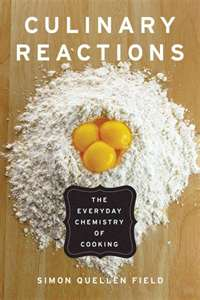Suzen often says, “Everybody eats.” And that’s true. It’s why lawyers, bankers, doctors, engineers and salespeople flock to Cooking by the Book for team building in the kitchen. People actually not only eat, they often cook. And they enjoy it.
Now, if you love to eat, if you love to cook, and you are really curious about how cooking works, then you are not “automatically” a geek. Although, in the 21st Century it is okay — if not necessary — to be a bit “geekish.” The more you cook, the more questions you may have:
- These two recipes for cupcakes are really different in their proportions for the ingredients. Does it matter?
- If I double the size of this bread recipe, how do I adjust the cooking time? And why?
- Why is hollandaise sauce so foreboding and how do I succeed the first time?
- Why does my sourdough starter have bacteria as well as yeast? And why do I need both of them?
- Why do cut apples turn brown and why does lemon juice prevent that browning?
Culinary Reactions is a wonderful new book that will be dear to the heart of many a geek, chemist, or true foodie. The book presents lots of questions and deftly answers them. Yes, there are chemical diagrams here and some equations, but’s all displayed with charming ease. And, there are plenty of English explanations so you really don’t have to make sure that the same number of atoms are on each side of those equations.
You don’t need a science degree to appreciate and learn from Culinary Reactions.
Author Simon Quellen Field is an accomplished science writer with a knack for educating us without overloading us. The book is a just a fun read, and you can pick it up and start with any chapter, including:
- Measuring and Weighing
- Foams
- Emulsions
- Colloids, Gels, and Suspensions
- Oils and Fats
- Solutions
- Crystallization
- Protein Chemistry
- Scaling Recipes Up and Down
- Heating
- Acids and Bases
- Oxidation and Reduction
- Boiling, Freezing and Pressure
Somewhere in that list of topics, there are things you probably want to know about — or even need to know more about to protect your food. If you have ever made fudge, and failed, then that chapter on crystallization will empower you to try, try again. If the new molecular styles of cooking and bartending intrigue you, then knowing more about foams and gels and other fabrications will let you appreciate the new cuisines. And perhaps help you turn your kitchen into you own private chemistry lab.
Culinary Reactions is a fun book. Any foodie will enjoy it. And, if you have a geek on your holiday shopping list, you can’t go wrong. Even geeks eat.

